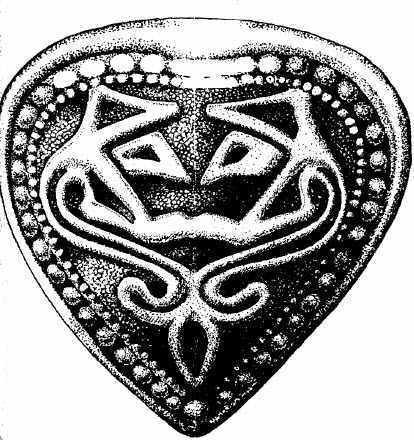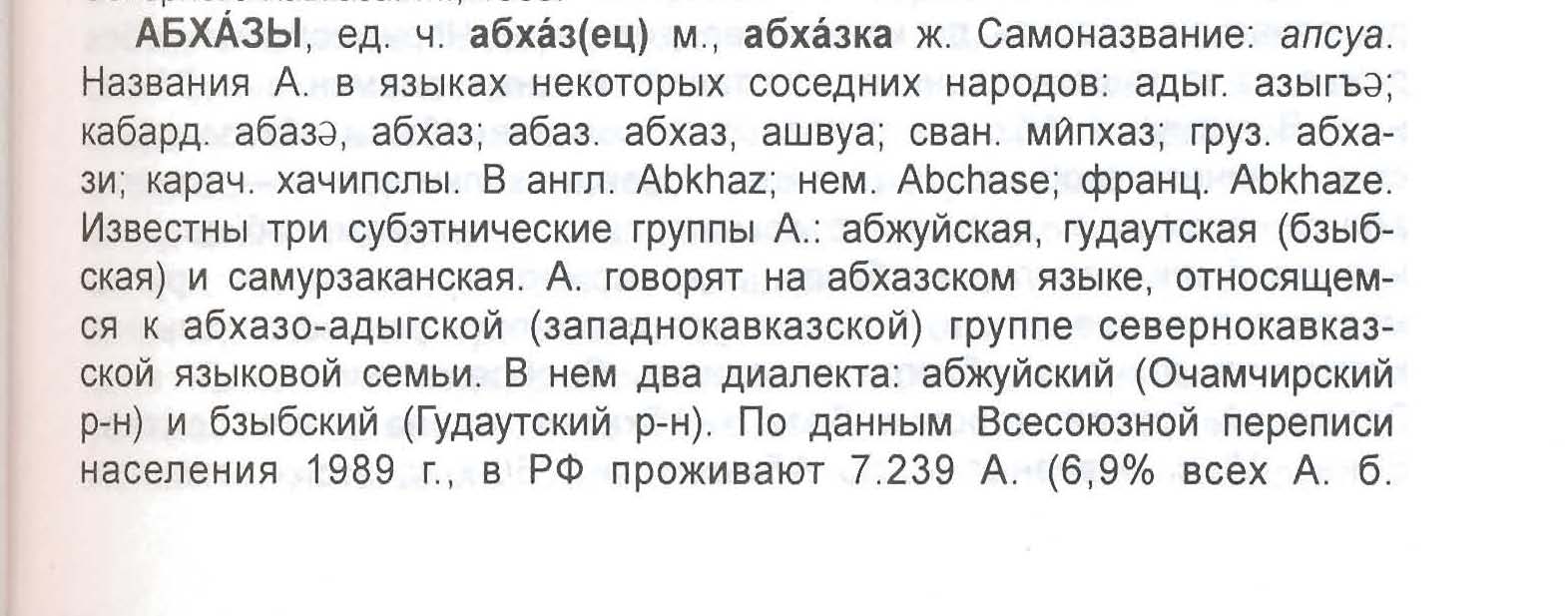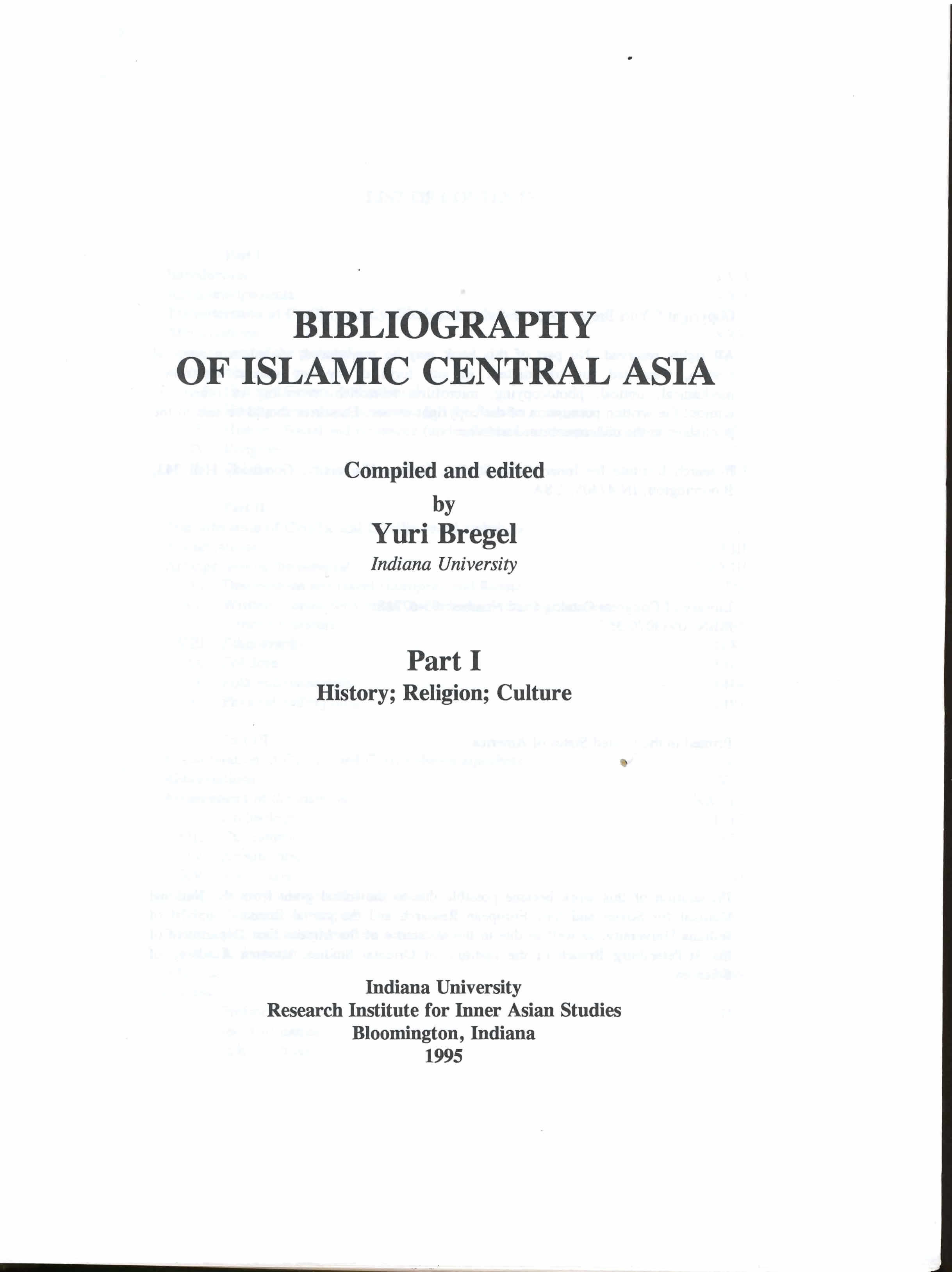INTRODUCTION
The ethnographic landscape of the Russian Federation presents researchers with an extraordinary historical narrative for the diversity of cultures, languages, and the numerous encounters that continue to shape the modern Russian state. This guide to Russian minorities is divided into the following sections: encyclopedias; dictionaries; bibliography of bibliographies; bibliographies; library catalogs; online resources. Specific bibliographies for regions and individual ethnic groups have been omitted to present general resources for the study of ethnic minorities in Russia. In addition to the general resources, researchers are encouraged to explore the INION catalogs (РОССИЙКАЯ АКАДЕМИЯ НАУК ИНСТИТУТ НАУЧНОЙ ИНФОРМАЦИИ ПО ОБЩЕСТВЕННЫМ НАУКАМ 1980- ), which contains approximately 3.5 milliion records( data as of 01.01.2012) for materials in the social sciences. The institute’s databases provide abstracts, keywords, subject headings, and author-title information for social sciences publications(approximately 140 languages). Researchers can freely access and search the institute’s databases. Scholars can also utilize EastView Russian National Bibliography database for recent publications on their respective areas of specializations. The subscription based database contains: Knizhnaia letopis’ ; Letopis’ zhurnal’nykh statei ; Letopis’ gazetnykh statei ; Letopis’ avtoreferatov dissertatsii ; Letopis’ retsenzii ; Letopis’ izoizdanii ; Kartograficheskaia letopis’ (1994-). Furthermore, researchers can have free access to ЛЕТОПИСь ЖУРНАЛьНЫХ СТАТЕЙ [ Letopis’ Zhurnal’nykh Statei Online Index (1956-1975) ] through the Indiana University Digital Library Program search interface[Note: Print: U of I Library Call Number: Main Stacks Reference 057 LE, 1926-].
ENCYCLOPEDIAS
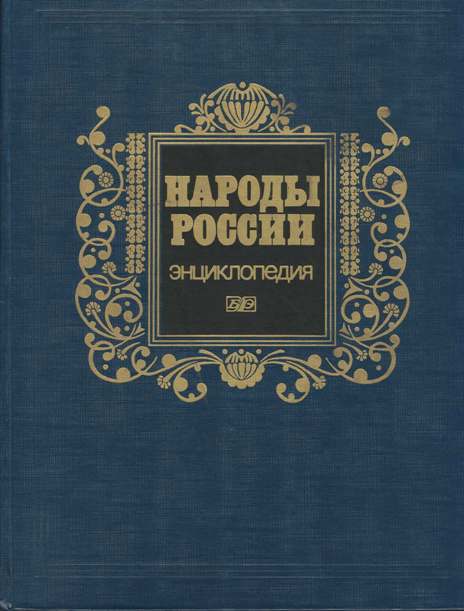 Narody Rossii. Ėntsiklopediia
Narody Rossii. Ėntsiklopediia
Tishkov, B.A. Institut Ėtnologii i Antropologii imeni N.N. Miklukho-Maklaia Rossiĭskoĭ Akademii Nauk. Moskva: Bol’shaia Rossiĭskaia Ėntsiklopediia, 1994. U of I Library Call Number: International & Area Studies Russian Reference (Slavic) 305.89171 N167. ISBN : 5852700827. Includes : Narody Rossiĭskoĭ Federatsii (po dannym perepisi naseleniia 1989); Natsional’nyĭ sostav sub’ektov rossiĭskoĭ federatsii [respublik, avtonomnoĭ oblasti i avtonomnykh okrutov, kraev i oblasteĭ, Moskvy i Sankt-Peterburga] (po dannym perepisi naceleniia 1989); Ėtnoiazykovaia situatsiia narodov Rossiĭskoĭ Federatsii (po dannym perepisi naceleniia 1989). Dolia gorodskogo i sel’skogo naceleniia u narodov Rossiĭskoiĭ Federatsii; Natsional’nyĭ sostav
Published in 1994 by the Institute of Ethnology and Archeology, Russian Academy of Sciences, this guide to “peoples of Russia” invites the reader to explore the various ethnic groups in the Russian Federation. The introduction provides an overview of languages and lists demographic distribution of ethnic groups in major cities, regions and republics. The entries are accompanied by illustrations and photographs of ethnic groups in traditional customs. In addition to the entries, the editors have also included a glossary of terms, bibliography, statistical information, index of ethnic groups, list of authors and abbreviations. This encyclopedic guide provides researchers with an excellent introduction to ethnic minorities in the Russian Federation.
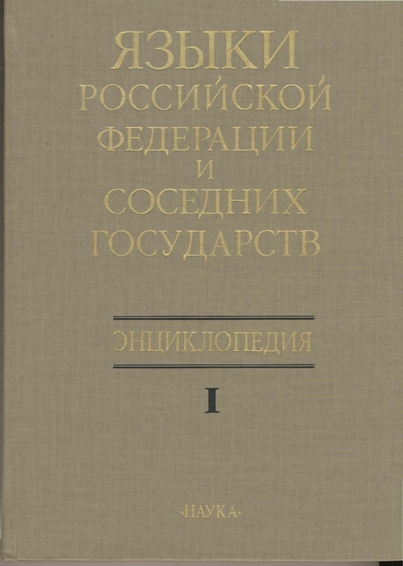 Iazyki Rossiĭskoĭ Federatsii i sosednikh gosudarstv. Ėntsiklopediia v trekh tomakh = The Languages of Russia and Adjacent States. Encyclopedia in 3 volumes .
Iazyki Rossiĭskoĭ Federatsii i sosednikh gosudarstv. Ėntsiklopediia v trekh tomakh = The Languages of Russia and Adjacent States. Encyclopedia in 3 volumes .
Rossiĭskaia Akademiia Nauk. Institut Iazykoznaniia RAN. Moscow: “Nauka,” 1997.
U of I Library Call Number: International & Area Studies Russian Reference (Slavic) 409.47 Ia92 v. 1-3. ISBN : 5020112372(v. 1); 5020112682 (v. 2); 5020112372(v.3).
According to the publisher, this encyclopedia, “…produced by Russia’s leading linguists, contains unique information on 150 languages, the history of their development, a description of their present state and of the families (groups) to which they belong.” With each entry, this three volume encyclopedic guide includes a detailed analysis of each language and contains a literature section for further study. The entries are also acompanied by illustrations that demonstrate the structure, phonetics, morphology, and syntax for each language. Researchers would find this guide to be an authoritative source for researching the languages of the Russian Federation and adjacent states.
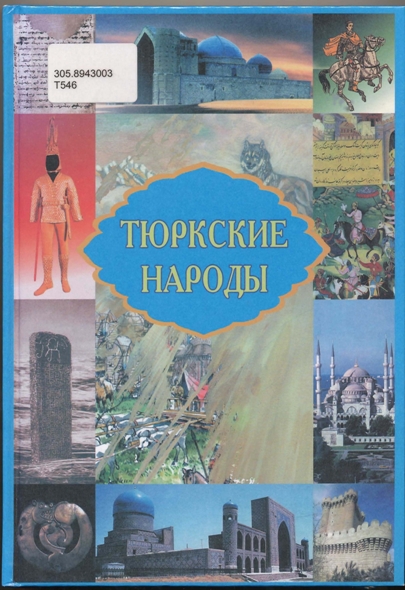 Tiurkskie narody: ėntsiklopedicheskiĭ spravochnik .
Tiurkskie narody: ėntsiklopedicheskiĭ spravochnik .
Aiagan, B. G. Almaty: ZAO “Kazak ėntsiklopediiasy,” 2004.
U of I Library Call Number: International & Area Studise Central Asian Reference (Slavic) 305.8943003 T546. ISBN: 9965-9389-6-2.
Published in 2004, this encyclopedia introduces its readers to the world of Turkic ethnic groups. This reference source is divided into the following sections: Turkic Republics; Autonomous Turkic Republics within the Russian Federation; and descriptions of other Turkic groups in the region. Entries for the autonomous republics in the Russian Fedeartion contain the following information: geographic location and description, political history, population statistics, economy, printing, libraries, museums, healthcare, education, music, etc. There are twenty nine descriptions in the “etnicheskie gruppy” section. Each entry provides a historical overview of the ethnic group, including location and linguistic analysis of the language and its relation to the Turkic languages of the region. The editors for this encyclopedic guide have also included a literature section for each entry and a table of contents (p. 382).
DICTIONARIES
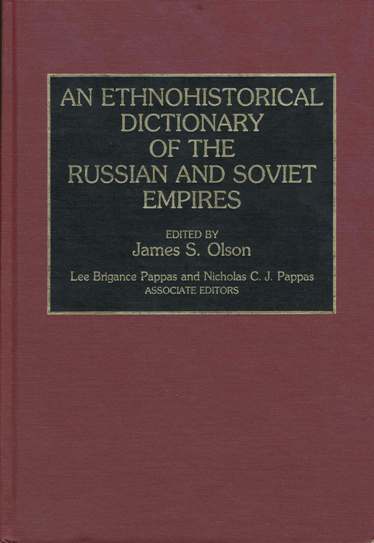 An Ethnohistorical Dictionary of the Russian and Soviet Empires .
An Ethnohistorical Dictionary of the Russian and Soviet Empires .
Olson, James S. Westport, Connecticut: Greenwood Press, 1994. U of I Library Call Number : International & Area Studies Russian Reference (Slavic) 305.800947 Et38. ISBN : 0-313-27497-5. Includes: Appendices : Appendix A : Major ethnic groups of the Soviet Union by republic, 1990; Appendix B : Ethnic populations of the Soviet Union, 1926-1989; Appendix C : A brief history of Islam, with speical reference to Russia and the Soviet Union; Appendix D : A Chronology of the Russian and Soviet Empires; Appendix E : Major political subdivisions of the Soviet Union in 1990; Appendix F : Nationality, language loyalty, and religion in the Soviet Union, 1989; Appendix G : Soviet residence patterns by major nationality group, 1989; Appendix H : Ethnic composition of the autonomous unites of the Soviet Union in 1991.
Published in 1994, this ethnohistorical dictionary “…includes entries on over 450 ethnic groups.” Edited by James S. Olson, An Ethnohistorical Dictionary of the Russian and Soviet Empires is intended “…to serve as a ready reference work for students, reserachers, librarians trying to sort out the political and social struggles in that part of the world. The editor has consulted previous ethnographic handbooks to compile this definitive ethnohistorical dictionary. The entries are cross-referenced, enabling the user to grasp the historical controversies, spelling variations, and the complexities associated with group idenity. Mr. Olson’s edited work provides an ethnopolitical overview for each ethnic group, followed by a list of references for further study.
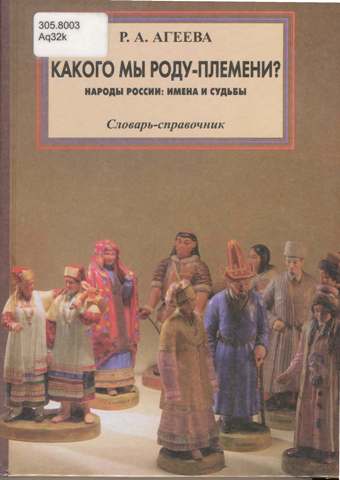 Kakogo my rody-plemeni? Narody Rossii: imena i sud’by. Slovar’-spravochnik .
Kakogo my rody-plemeni? Narody Rossii: imena i sud’by. Slovar’-spravochnik .
Ageeva, R. A. Otdelenie literatury i iazyka Rossiĭskoĭ akademii nauk. Moskva: Academia, 2000.
U of I Library Call Number: Main Stacks 305.8003 Aq32k. ISBN : 5-87-444-033-X.
Published by the Russian Academy of Sciences, this guide/ dictionary to “the peoples of Russia” includes: a historical overivew for each ethnic group; masculine-feminine and plural spelling variations in Russian; ethnic group identifiers in the vernacular language, English, German, and French; “language and dialect” section with statistics; geographical location; and a literature section. Researchers will find the multilingual ethnic group identifiers to be beneficial for searching integrated catalogs, online databases, and national libraries (see below).
Moreover, the editor has also included a glossary (pp. 421-422), a list of abbreviations (pp. 9-10), and the structure of the dictionary (pp. 8-9).
BIBLIOGRAPHIES OF BIBLIOGRAPHIES
Bibliografiia kraevedcheskoĭ bibliografii RSFSR (1833-1960). Annotirovannyĭ ukazatel .
Ch. 1 : Obshchie i otraslevye bibliografii kak istochnik kraevetscheskoĭ bibliografii RSFSR. Ch. 2 : Bibliografiia geograficheskikh i ėkonomicheskikh raĭonov, kraev, oblasteĭ i avtonomnykh respublik RSFSR. Ch. 3 : Sovdnye vspomogatel’nye ukazateli ko vsem vypuskam [avtorov; zaglaviĭ; geograficheskikh nazvaniĭ]. Spisok istochnikov. Leningrad: Gosudarstvennoĭ publichnoĭ biblioteki im. M. E. Saltykova-Shchedrina, 1964-.
U of I Library Call Number: International & Area Studies Russian Reference (Slavic) 016.947B4713. U of I Library Call Number: History, Philosophy, & Newspaper FILM 016.947B4713 (1976-90 Part 1).
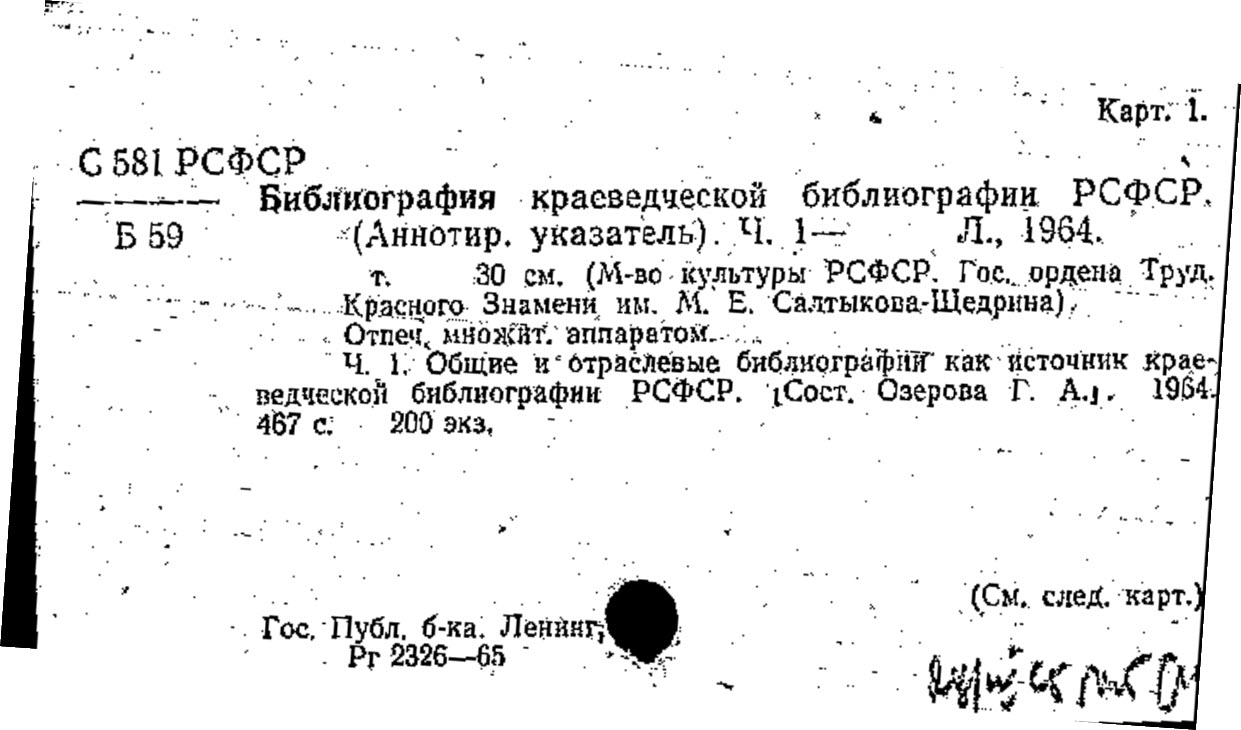
This bibliography of bibliographies is catalog of materials published in Russian from 1833 to 1960. There are three parts to this bibliography, with a total of 1030 entries for titles. The entries are numerically organized with annotations. Each part to this bibliography of bibliographies contains topical subsections. Researchers interested in locating ethnographic materials should consult the following subheadings: “Istoriia,” pp. 259-294; “Arkheologiia,” pp. 295-317; “Antropologiia,” pp. 318-321. The compilers have provided scholars with a detailed overview for each of three sections (pp. 7-12). Researchers can access individual publications by using the table of contents (pp. 2-6) or through the indices (author, title, and geographic indices). See below.
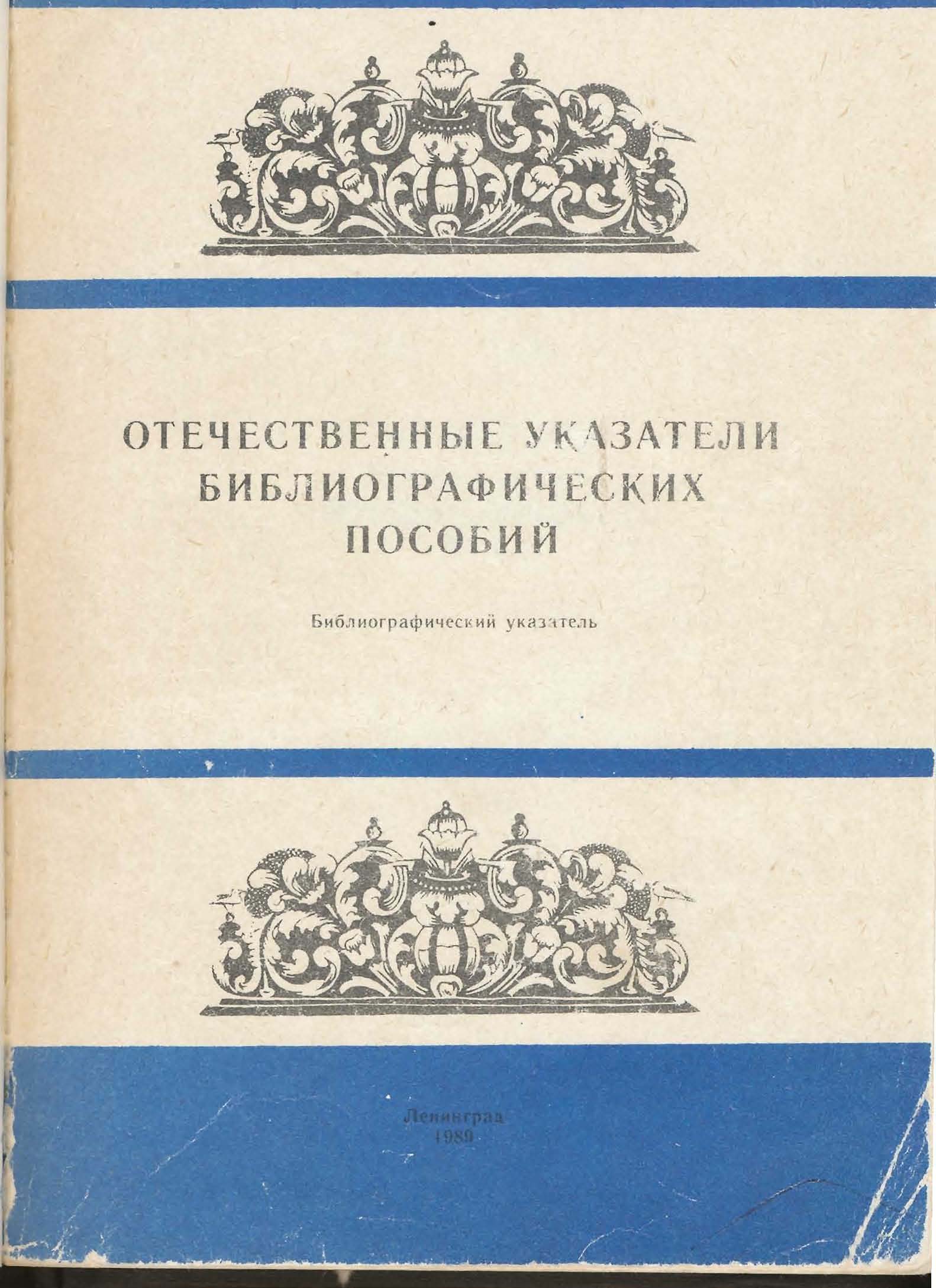 Otechestvennye ukazateli bibliograficheskikh posobiĭ
Otechestvennye ukazateli bibliograficheskikh posobiĭ
Kandel’, Boris L’vovich (1916-). Leningrad: Gosudarstvennaia publichnaia biblioteka im M. E. Saltykova-Shchedrina, 1989. U of I Library Call Number: International & Area Studies Russian Reference 016.01547K131o1989. Note: International & Area Studies Library has two copies (1989 edition). 1984 edition: film format. U of I Library Call Number: History, Philosophy, & Newspaper FILM 016.01 K13o. Indices : Ukazatel'(avtorov, sostaviteleĭ, redaktorov i drugikh lits, upomianutykh v opisaniiakh i annotatsiiakh; rabot, opisannykh pod zaglaviem, pp. 210-221. Ukazatel’ prodolzhaiushchikhsia bibliograficheskikh izdaniĭ, p.222.
Published in 1989, the period of coverage for this bibliography of bibliographies is from the mid-nineteenth century to 1988. This annotated guide to Russia-USSR bibliographies contains approximately 1072 entries. This bibliography is dividied into five sections: bibliography of bibliographies (pp. 10-12); a list of universal bibliographic guides (pp. 13-93); subject bibliographies (pp. 95-186); list of sources on bibliographers (pp. 187-209); a master index to the entire bibliography (pp. 210-221). The compiler has inclduded an introductory chapter, which provides an overview for this bibliography. For some entires, the compiler lists the table of contents with extended annotations, while others receive brief notes on their content. Researchers with ethnographic inquries, should consult the second part to this bibliographies(pp. 54-77), for it contains: local history bibliographies and guides to various regions and ethnic republics. The “Kavkaz” section (entries 163-165), contains this entry for researching Southern Caucasus (see below).
BIBLIOGRAPHIES
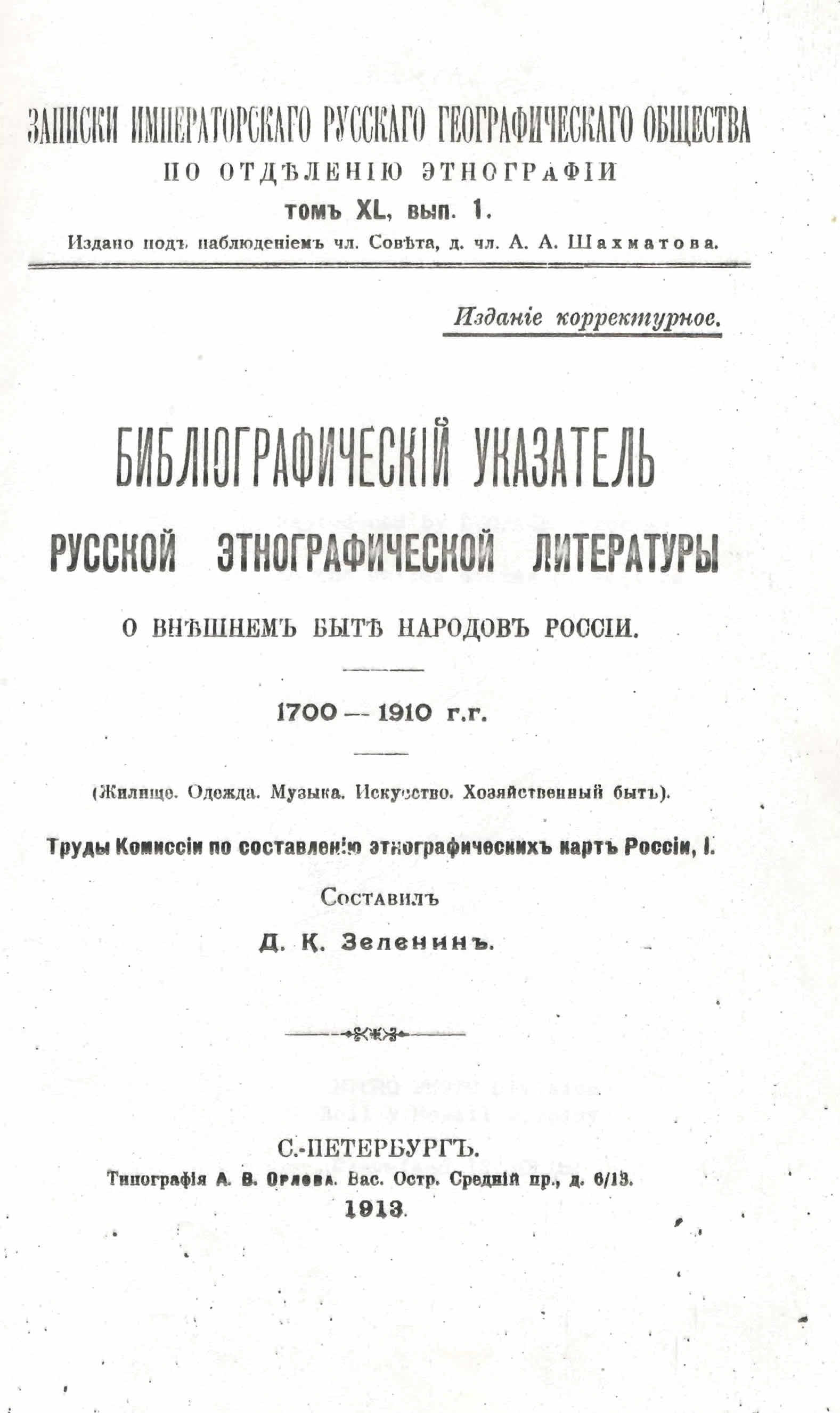 Bibliograficheskii ukazatel’ russkoĭ ėtnograficheskoĭ literatury o vnieshnem” bytie narodov” rossii, 1700-1910 g.g.
Bibliograficheskii ukazatel’ russkoĭ ėtnograficheskoĭ literatury o vnieshnem” bytie narodov” rossii, 1700-1910 g.g.
Zelenin, Dmitrii Konstantinovich(1878-1954) . S.-Peterburg”, 1913. Indices : 1 . “Aflavitnyĭ ukazatel’ guberniĭ i oblasteĭ,” pp.632-638. 2. “Alfavit’ narodnosteĭ i plemnnykh” grupp’ upominaemykhie v’ bibliograficheskom” ukazatelie,” pp. 638-646 3. “Ukazatel’ ėtnograficheskikh” kart,” pp.646-6 48. 4. Ukazatel’ knig” i stateĭ bibliograficheskago soderzhaniia,” pp.846-654. 5. Alfavitnyi ukazatel’ avtorov,”‘ pp. 654-733.
U of I Library Call Number: International & Area Studies Russian Reference (Slavic) 016.572947 Z37b
Published in Zapiski imperatorskago russkago geograficheskago obshchestva po otdieleniiu ėtnografii , Tom XL, Vyp.1 (1913), Dimitrii Konstantinovich’s bibliographic guide covers the ethnographic landscape of Russia from 1700-1910. This invaluable bibliography is divided into eight sections: the sections in turn are further divided and accompanied by numerical entries for each heading, allowing researchers to navigate through this guide with ease. Zelenin’s insightful work has sections for individual ethnic groups; regions; and ethnomusicology. Using language family affiliation, the entries are organized in the following manner: “Prochie indoevropeiskie narody,” No. 1399-1460; “Semity,” No. 1461-1470 [Note: separate section for “Karaimy i Krymchaki,” No. 1471-1474]; “Finno-Ugry,” No. 1475-1721 [Note: Zelenin includes the Chuvash in this section]; “Turki,” No. 1722-1905; “Paleaziaty,” No. 1941-2004 [Note: Zelenin places the Tungusic peoples, Chinese, and Koreans in this section.]; “Narody kavkaza,” No. 2005-2280 [Note: Kurds are included in this section]. With a total of 8847 entries, this bibiliographical guide is essential for researching Russian minorities.
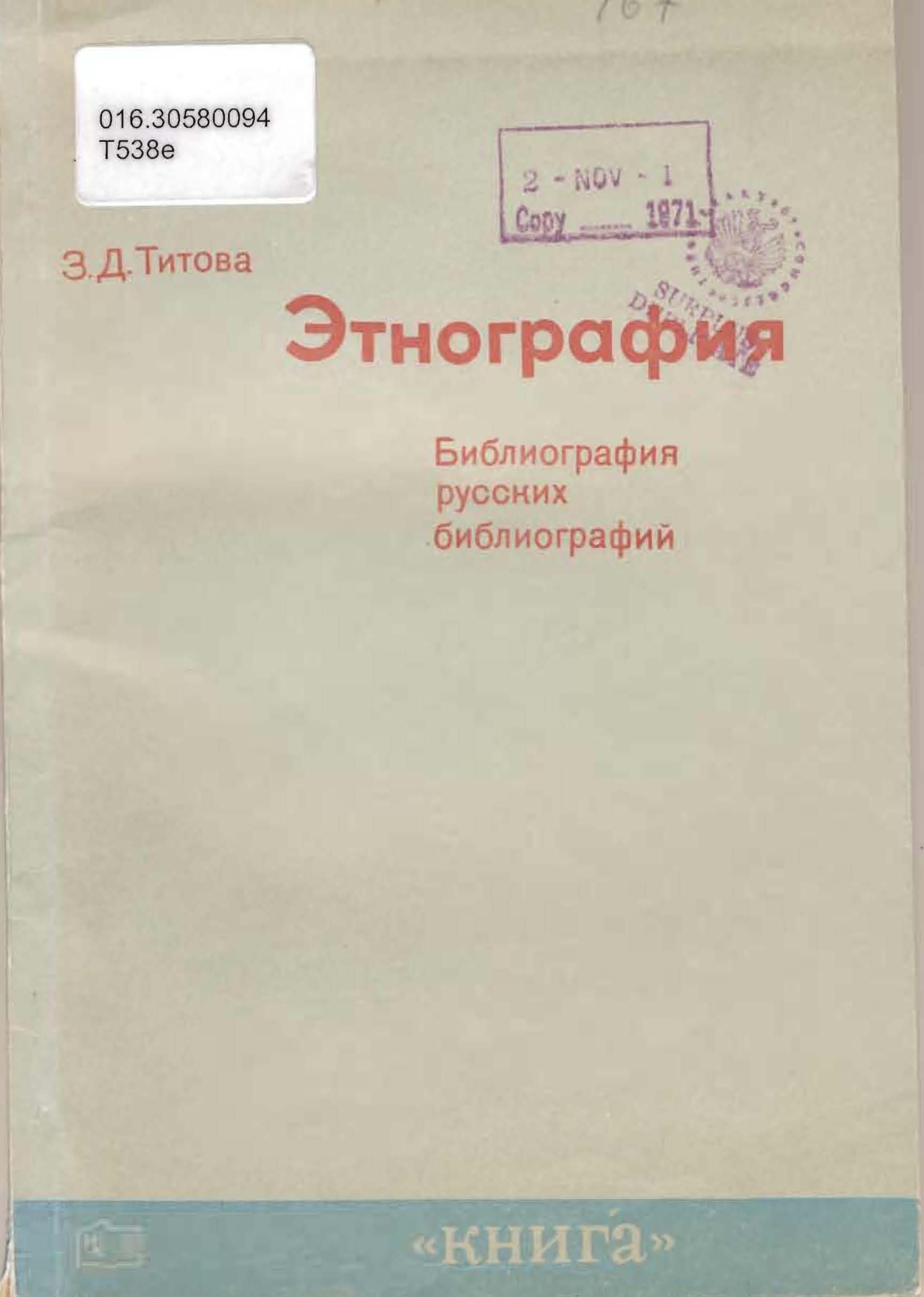 Ėtnografiia: bibliografiia russkikh bibliografii po ėtnografii narodov SSSR (1851-1969).
Ėtnografiia: bibliografiia russkikh bibliografii po ėtnografii narodov SSSR (1851-1969).
Titova, Zoiia Dmitrievna. Moskva: “Kniga”, 1970. U of I Library Call Number: International & Area Studies Russian Reference (Slavic) 016.30580094 T538e. Indices: Ukazatel’ ėtnicheskikh nazvaniĭ, pp. 109-114; Ukazatel’ imen i zaglaviĭ kollettivnykh rabot, pp. 115-124; Predmetno-geograficheskiĭ ukazatel, pp. 125-138.
Published in 1970, Zoiia Dmitrievna’s bibliography contains 734 entries. This bibliographic guide is divided into the following sections: Evropeĭskaia chast’ SSSR; Kavkaz; Aziatskaia chast’ SSSR. Sibir’ i Dal’niĭ Vostok; Sredniaia Asiia i Kazakhstan; ‘Personalia’ ėtnografov. Researchers would the find introductory section to be extremely beneficial, for it contains a list of ethnographic bibliographies, statistical publciations, and geographical guides. The entries are numerically organized with the names of the authors in bold font. With the presence of three indicies, researchers will comfortablly navigate through this bibliographic guide. Zoiia Dmitrievna, in addition to providing an introductory section, lists general works for each section, followed by bibliographies and reference sources, making this bibliography an integral part of addressing any Russian ethnographic research inquires.
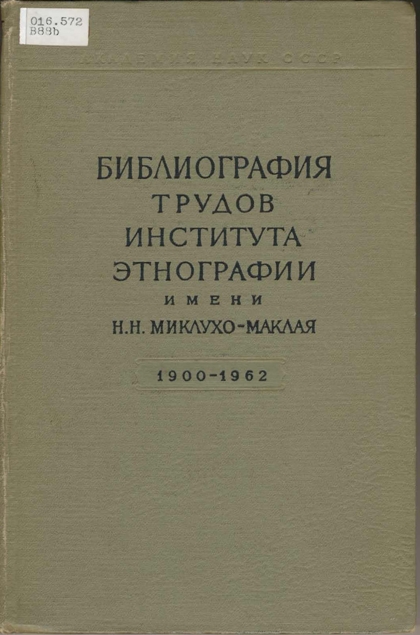 Bibliografiia trudov instituta ėtnografii im. N.N. Miklukho-Maklaia 1900-1962.
Bibliografiia trudov instituta ėtnografii im. N.N. Miklukho-Maklaia 1900-1962.
Bunakova, O.B; Kamenetskaia, P.B. Leningrad: Nauka, 1967.
U of I Library Call Number: International & Area Studies Russian Reference (Slavic), Main Stacks, and Oak Street Facility 016.572 B88b.
Sections: “Raboty obshchego kharaktera,” pp. 11-51. Obshchie i teoreticheskie raboty po ėtnografii, pp52-64. Ėtnografiia narodov SSSR, pp. 65-168. Ėtnografiia narodov zarubezhnykh stran, pp. 169-219. Antropologiia, pp. 220-234; Antropologiia sovremennogo naseleniia zarubezhnykh stran, pp. 234-235. Indices: Ukaztel’ ėtnicheskikh nazvanii, pp. 236-245. Imennoi ukazatel’ (Avtory i redaktory knig, statei i retsenzii, pp. 246-269. Soderzhanie, pp. 270-275. Note: Table of Contents: French, pp. 276-281; Russian, 270-275.
This bibliiography consists of materilas published by the Institute of Ethnology and Anthropology from 1900-1962. With a total of 5195 entires, this bilbiographic guide includes the following: a publication list with volume/issue numbers and titles for serials associated with the institute [For example: Trudy Instituta Ėtnografii im. N. N. Miklukho-Maklaia (Novaia Seriia), Tom 1 (1947) – Tom 80(1962), individual volume titles are listed for this serial publication, see pp. 8-10. ]; proceedings of organizations and congresses; methodological handbooks; musuem publications; bibliographies; and biobibliographical entries for researching prominent ethnographers (see “Personalia,” pp. 38-46). The compilers have enclosed subject and author indices for the researcher’s convenience. This bibliography (1900-1962) offers the researcher a chance to view the publication history (1900-1962) of a preeminent institution for ethnography in Russia.
Literatura russkoĭ geografii, statistiki i ėtnografii… Tom 1-9 (1861-1883) .
Note: Tom 3-9 were published as supplements to Izviestiia Mezhov, Vladimir Ismaĭlovich(1830-1894).Note: S.-Peterburg: tipografii V. Bezobrazova i komp., 1861-1883. U of I Library Call Number: International & Area Studies Library Russian Reference (Slavic) 016.9147 M57L. Note: U of I holdings for this title are incomplete.
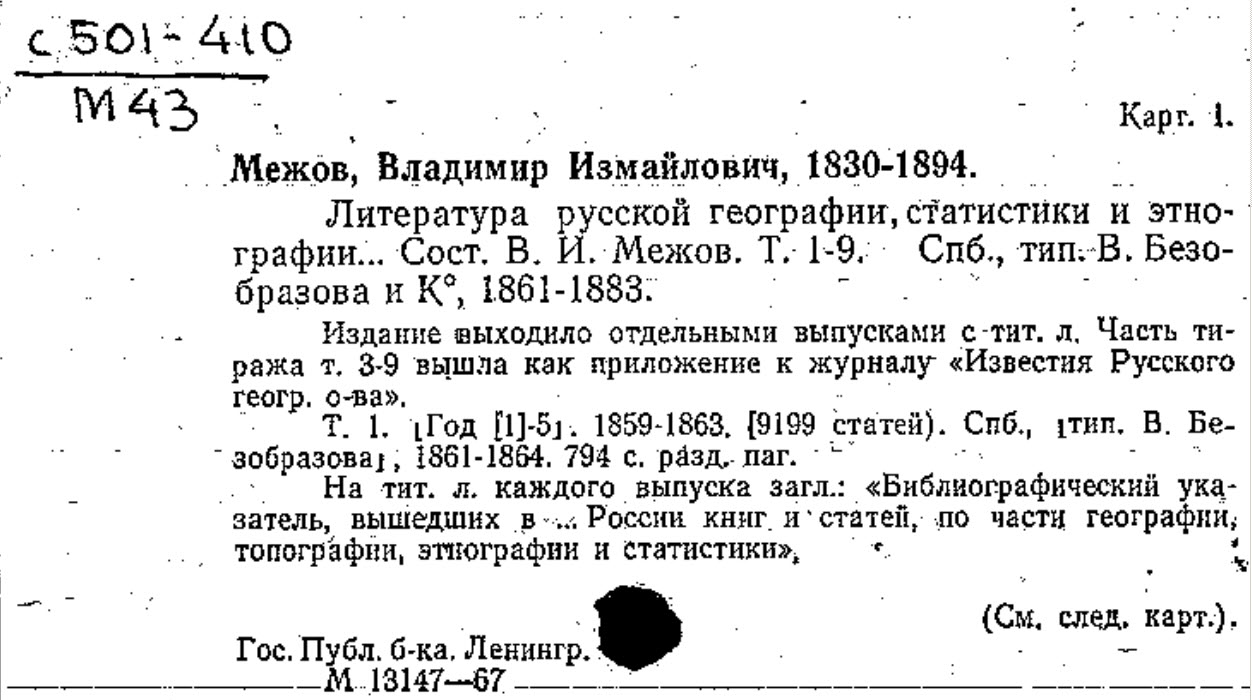
Published as a supplement to Izviestiia Imperatorskago Russkago geograficheskago obshchestva [Note: Tom 3-9], Literatura russkoĭ geografii, statistiki i ėtnografii is a multivolume guide to ethnography, physical and human geography, from 1861-1883. According to the National Library of Russia, this bibliography contains the following: Tom 1(1-5): 9199 articles, 1859-1863; Tom 2(6-8): 7505 entries for monographs and articles, 1864-1866; Tom 3 (9-10): 6555 entries for monographs and articles, 1867-1868; Tom 4(11-12): 7667 entries for monographs and articles, 1869-1870; Tom 5(13-14): 9675 entries for monographs and articles, 1871-1872; Tom 6 (15-16): 10, 299 entries for monographs and articles, 1873-1874; Tom 7(17-18): 11351 entries for monographs and articles, 1875-1876; Tom 8(19-20): 11086 entries for monographs and articles, 1877-1878; Tom 9(21-22): 11,429 entries for books and articles. In addition to this bibliographic guide, Researchers will find Mezhov’s other bibliographies to be particularly useful for researching ethnography: Bibliografiia Azii , Bibliografiia evreiskogo voprosa, and Sibirskaia bibliografiia .
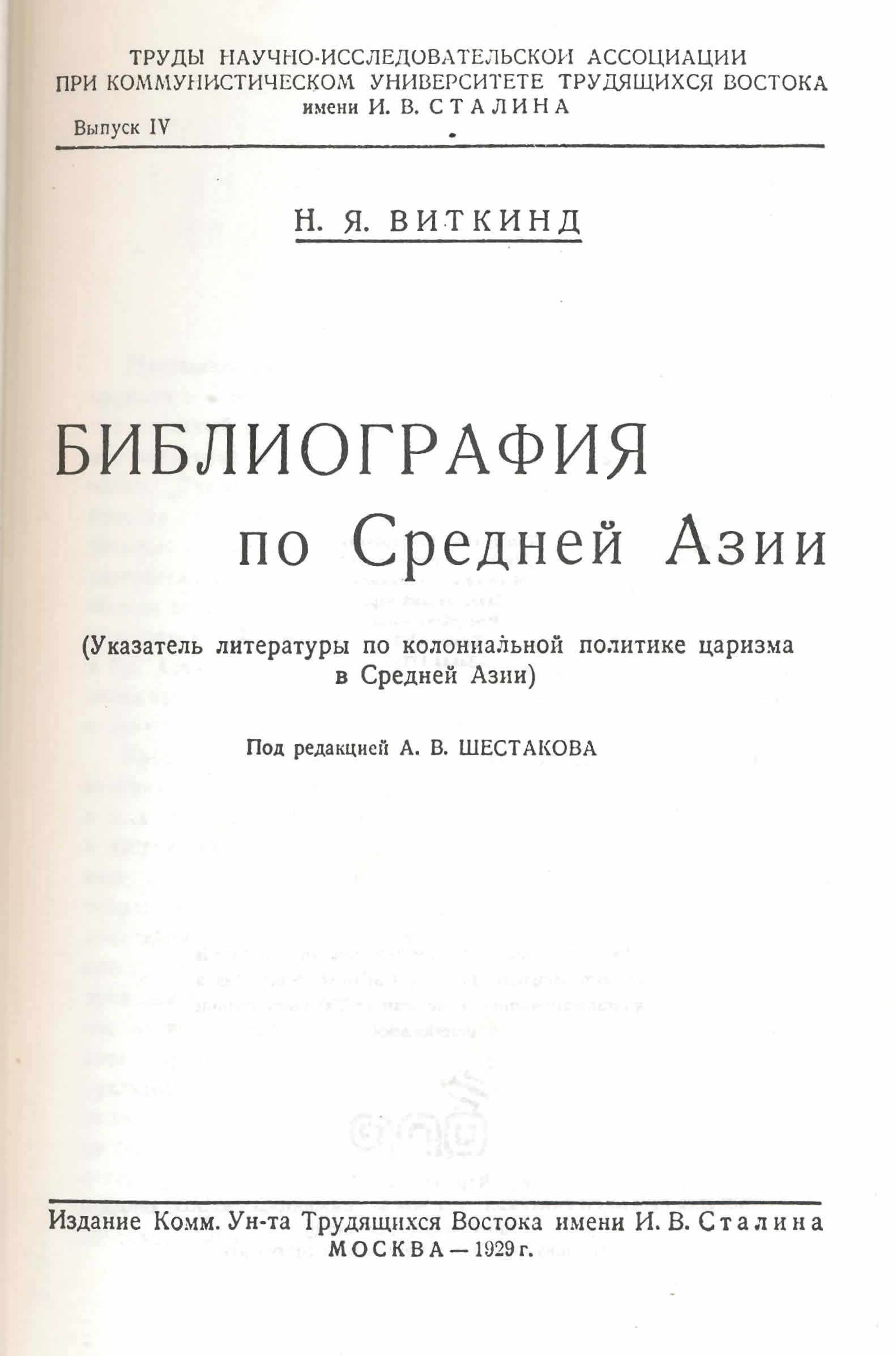 Bibliografiia po Sredneĭ Azii: ukazatel’ literatury po kolonial’noĭ politike tsarizma v Sredneĭ Azii.
Bibliografiia po Sredneĭ Azii: ukazatel’ literatury po kolonial’noĭ politike tsarizma v Sredneĭ Azii.
Vitkind, N. IA. Series: Trudy Nauchno-issledovatel’skoi assotsiatsii pri kommunisticheskom universitete trudiashchikhsia vostoka, vyp. 4. Cambridge: Oriental Research Partners, 1971. Note: reprint of the 1929 edition. U of I Library Call number: International & Area Studies Russian Reference 016.9584 v83b1972
This annotated guide to Central Asia and Russian colonial politics addresses the period from mid-nineteenth century up to the revolution of 1917. This bibliography contains approximately 1271 entries. Originally published in 1929, this bibliography is organized numerically and divided into three main sections: bibliographies, pp. 9-15; monographs, pp. 16-94; journal articles, pp. 95-152. In addition to these sections, the compiler has included the following: a systematic index, alphabetical list of reviewers, a list of serials, handbooks, and dictionaries. Among the guides listed in the “bibliography section,” entries #27-#29 list official documents (see below).
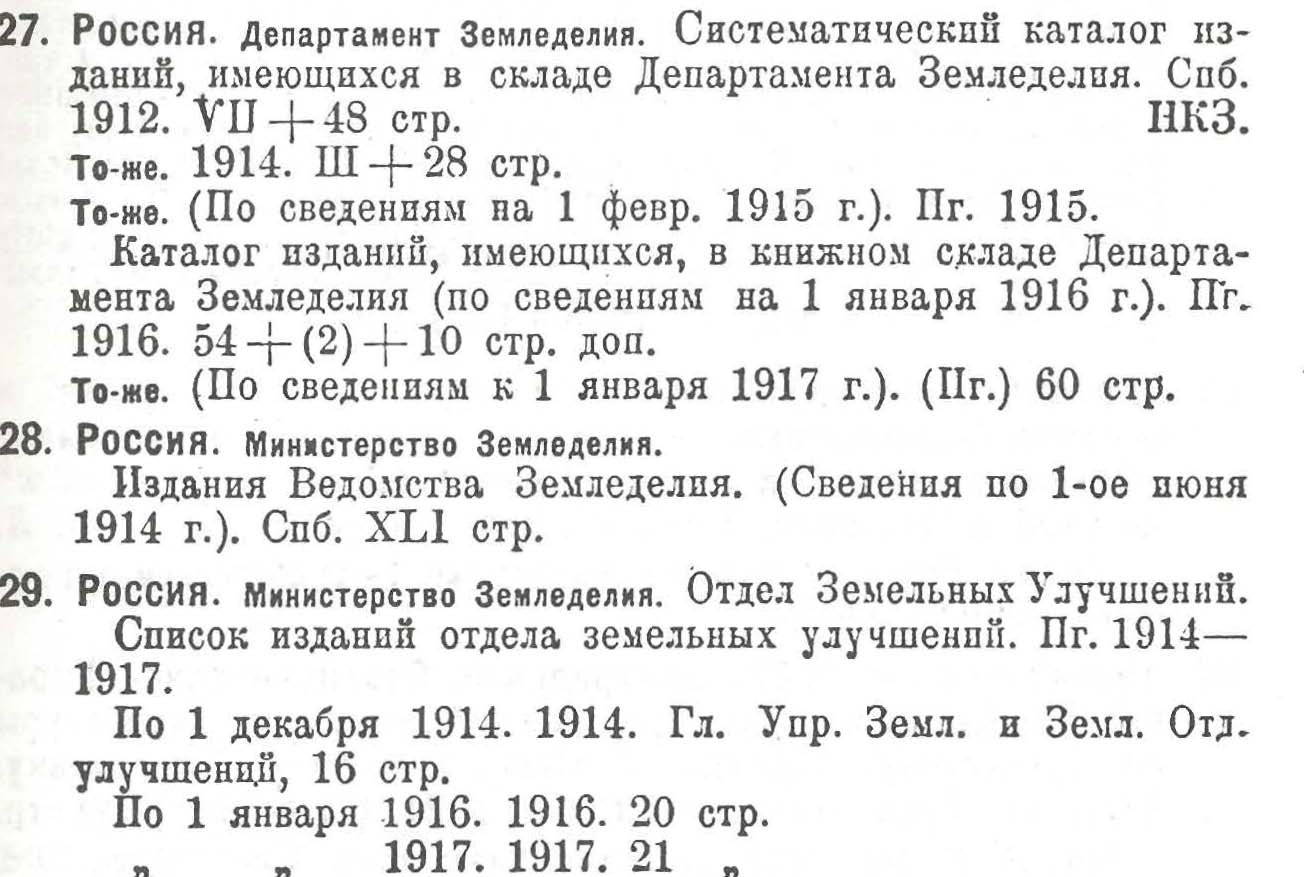
Bibliography of Islamic Central Asia
Indiana University Uralic and Altaic Series, Volume 160, Part I-III. Bregel, Yuri. Bloomington, Indiana: Research Institute for Inner Asian Studies, 1995.
U of I Library Call Number: International & Area Studies Central Asian Reference (Slavic) 016.958B746b
v. 1-3. ISBN: 0933070-357. Part I: History; Religion; Culture. Part II: Descriptions and travel; Written sources for Central Asian history; Ethnography; Folklore: Folk entertainments; Physical anthropology. Part III: Archeology; Numismatics; Architecture; Visual arts; Auxiliary historical disciplines; Historical geography; Historiography; Bibliography; Addenda; Indexes. Indices: Index of names (authors, translators, editors, reviewers), pp. 2103-2219; Index of titles (anonymous works, and bibliographical entries, in which the name of author does not precede the title), pp. 2220-2276.
Published in 1995, this bibliography is divided into three parts: “pre-Islamic Central Asia”, “Islamic Central Asia before the establishment of communist regimes in Russia and China,” and “Islamic Central Asia under the communist regimes.” In his introductory remarks, Dr. Bregel cites these sources as the basis for this compiled work: Soviet bibliographical annals; other general bibliographies; general, regional and topical bibliographies of Central Asia; Lists of publications of individual scholars; entire sets of periodicals and encyclopedias. The compiler has limited the scope of this bibliograpy to history, “with all its auxiliary fields and related disciplines, like archeology and ethnography.” This bibliography is subdivided into sixteen sections and includes the following: “monographs and articles in periodicals and collective volumes in all languages, except Chinese and Japanese, published from the 17th century A.D. to 1988 (please see footnote 31 for additional comments). The entries for monographs are listed first and followed by articles. Due to the complexities assoicated with transliteration systems, the compiler lists the names of the authors as “they appear in the original.” Morever, “…any variant spellings of an author’s name… are listed separately in the index, with other spellings cross-referenced.” Researchers can browse the extensive ethnography section through subheadings or individual ethnic groups (Section VIII, Volume II, pp. 1081-1381).
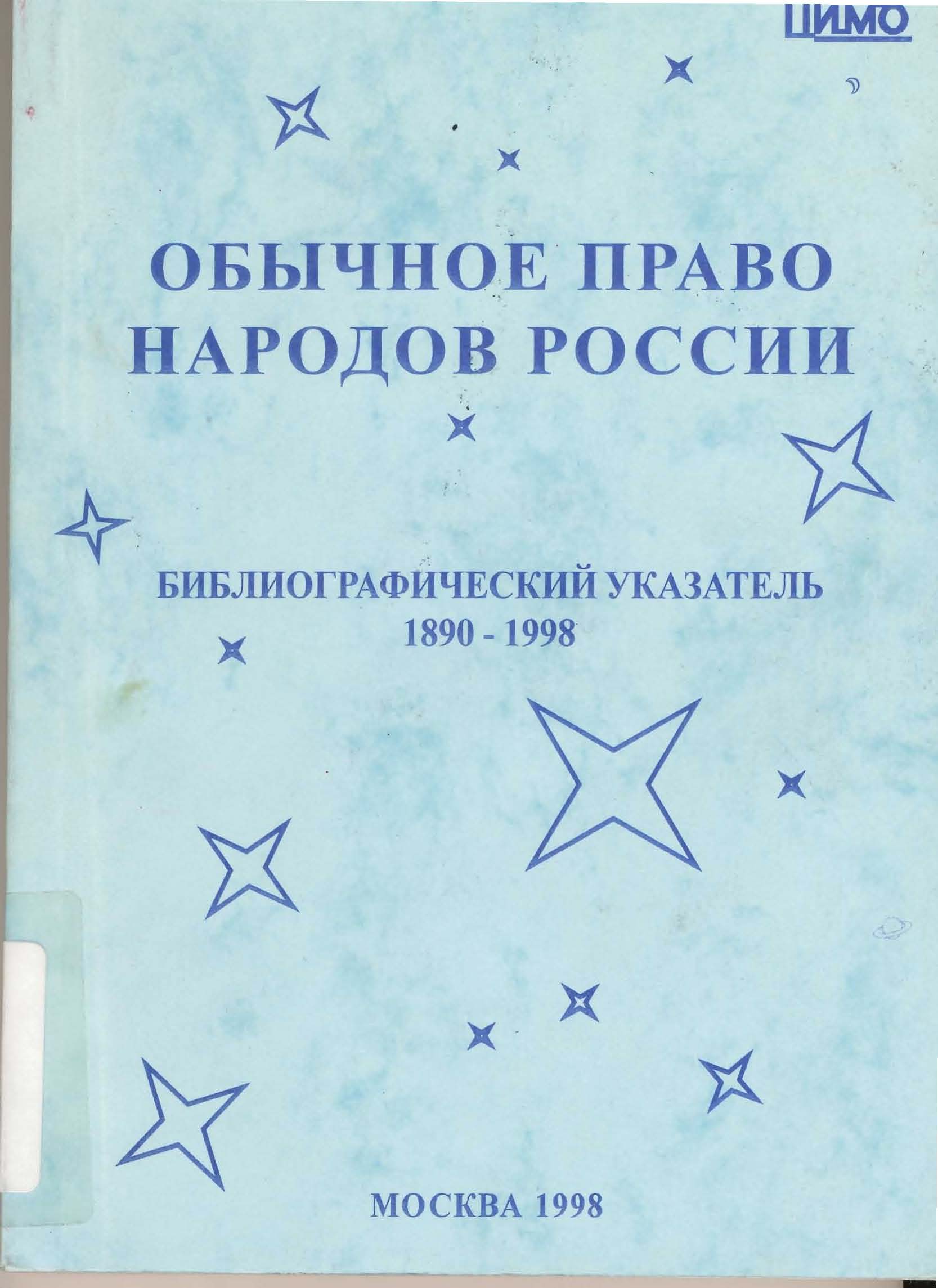 Obychnoe pravo narodov Rossii. Bibliograficheskiĭ ukazatel’ 1890-1998.
Obychnoe pravo narodov Rossii. Bibliograficheskiĭ ukazatel’ 1890-1998.
Rossiĭskaia Akademiia nauk. TSentr po izucheniiu mezhnatsional’nykh otnosheniĭ. Instituta ėtnologii i antropologii. Nikishenkov, A. A. Moskva: Staryĭ sad, 1998.
U of I Library Call Number: International & Area Studies Russian Reference (Slavic) 016.34050947N584o.
ISBN: 5-89930-007-8. Index:Ukazatel’ avtorov, sostaviteleĭ i redaktorov, pp. 230-244. List of Abbreviations, pp. 227-229.
This guide to customary laws, which contains approximately 2000 entries for articles, monographs, and proceedings, incorporates previous works by E. I. Iakushkin [Evgeniĭ Ivanovich Iakushkin, 1826-1905]. Specifically, his multi-volume guide, Obychnoe pravo. Materialy dlia bibliografii obychnogo prava (Vyp. 1-4). The compilers have divided this bibliography into six sections: “Teoriia i metodologiia normativnoĭ ėtnologii (iuridicheskoĭ, ili pravovoĭ antropologii); “Obychnoe pravo russkogo krest’ianstva” ; Obychnoe pravo zemledel’cheskikh narodov Evropeĭskoĭ Rossii”; “Obychnoe pravo narodov Kraĭnego Severa, Sibiri i Dal’nego Vostoka”; “Obychnoe pravo narodov Kavkaza”; Obychnoe pravo narodov stepnoĭ Rossii, Kazakhstana i Sredneĭ Azii.” The entries are organized alphabetically by author, in the absence of authors, titles are listed first. Bibliographic data for entries in foreign languages are listed at the end of each section. The languages represented are German, English, and French.
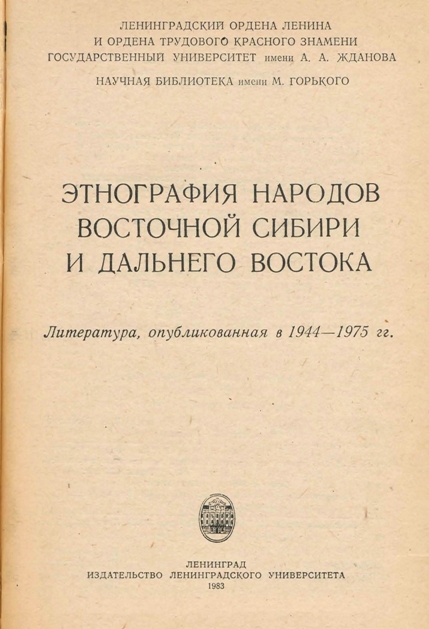 Ėtnografiia narodov vostochnoĭ Sibiri i Dal’nego Vostoka: literatura, opublikovannaia v 1944-1975 gg .
Ėtnografiia narodov vostochnoĭ Sibiri i Dal’nego Vostoka: literatura, opublikovannaia v 1944-1975 gg .
Leningrad: Izdatel’stvo Leningradskogo Universiteta, 1983. Index: Imennoĭ ukazatel, pp. 91-97.
U of I Library Call Number: International & Area Studies Russian Reference (Slavic) 016.30609577 An23e.
This bibliography contains approximately 1400 entries for monographs and articles from handbooks and periodical publications, published during 1944-1975 period in the Russian language. Researchers interested in Eastern Siberia and the Russian Far East can examine this guide through the following sections: “Narody Vostochnoĭ Sibiri i Dal’nego Vostoka,” pp. 5-51; “Ėvenki (Tungusy),” pp. 51-61. “Ėveny (Lamuty),” pp. 62-64; “Dolgany,” p. 64; “Chukchi,” pp. 64-70; “Koriaki (Nymylany),” pp. 70-73; “Iukagiry (Chuvantsy),” p. 73; “Negidal’tsy,” p. 74; “Nanaĭtsy (Gol’dy),” pp. 74-77; “Ul’chi,” pp. 77-78; “Orochi,” p. 78; “Orochi,” p. 78; “Udėgeĭtsy,” pp. 78-80; “Oroki,” p. 80; “Nivkhi (Giliaki),” 80-83; “Itel’meny (Kamchadaly),” pp. 83-85; “Aleuty,” pp. 85-86; “Ėskimosy,” pp. 86-90. The entries in this bibliographic guide are organized numerically and an index to authors is also included for researchers.
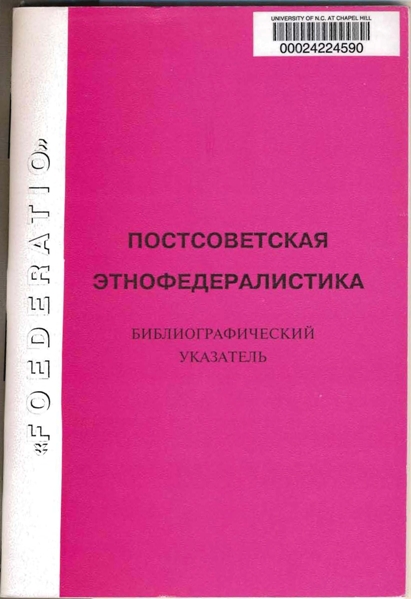 Postsovetskaia ėtnofederalistika: bibliograficheskii ukazatel .
Postsovetskaia ėtnofederalistika: bibliograficheskii ukazatel .
Filippov, V.R. Moskva: Tsentr tsivilizatsionnnykh i regional’nykh isslednovannii RAN, 2002. OCLC Accession Number : 53145530. Sections: Ėtnofederalistika kak osoboe napravlenie issledovatel’skoi mysli (ot sostaviteliia); 2. Monografii i otdel’nye izdaniia; 3. Tematicheskie sborniki; 4. Stat’i v tematicheskikh sbornikakh; 5. Stat’i v periodicheskikh izdaniiakh; 6. Materialy nauchnykh konferentsii i “kruglykh stolov”; 7. Bystupleniia na konferentsiiakh, tezisy dokladov; 8. Dissertatsionnye issledovaniia.
Published in 2002, this bibliography examines the relationship between the various ethnic groups and the federal government of the Russian Federation. This bibliographic guide is divided into five categories: books and other publications; dissertations; handbooks; and thematic articles organized according to the date of publication. This guide also includes a list of conferences and congresses for ethnic groups. There are 133 entries for monographs, 316 entries for articles, 48 entries for conference proceedings, and 18 entries for handbooks and collected works. Researchers studying ethnic relations and federalism in the Russian Federation would find this bibliograpy to be beneficial for their research interests.
LIBRARY CATALOGS
Svodnyi elektronnyi katalog na Finno-Ugorskikh iazykakh = the Union Catalogue of Publications in Finno-Ugric Languages.
URL: http://www.nlr.ru/rlin//ruslbr_v3.php?database=ONL

According to the National Library of Russia, the Union Catalogue of Publications in Finno-Ugric Languages “…contains bibliographic details for publications in Finno-Ugric languages, covering Ingrian, Lappish, Karelian, Khanty, Komi, Mansi, Mari, Mordvin, Udmurt, Veps.” The union catalogues lists “every publication in Ingrian, Lappish, Khanty, Mansi or Veps, in the National Library of Russia.” Furthermore, the National Library of Russia has consulted the following libraries to compile its list of records for pre-revolutionary publications: National Libraries of Republics of Karelia, Komi, Mari-El, Mordovia, Udmurtia, National Library of Finland, and the Library of the Research Institute of Languages of Finland. The union catalog has also incorporated materials in Finno-Ugric languages published since 2000. Moreover, the catalog lists availability at the National Library of Russia and National Libraries of Finno-Ugric Republics (See below).

Please note: When using this catalog, the National Library recommends using Internet Explorer. Transliteration Guide.
Ėlektronnyi katalog knig na iazykakh narodov RF i stran SNG =the electronic catalog of publications (monographs) in languages of the Russian Federation and CIS
URL: http://www.nlr.ru/rlin/ruslbr_v3.php?database=ONL2

It “…contains bibliographic records for items in all languages of the Russian Federation other than Russian.” Specifically, the eletronic catalog “…lists every publication in Palaeosiberian languages (Chukchi, Koryak, Eskimo etc), Samoyedic languages (Nenets, Nganasan, Selkup etc), and Manchu-Tungus languages (Evenki, Oroqen etc), held in the National Library of Russia.” Monographs published since 2000 in other languages of the Russian Federation are also included in this catalog.

Please note: When using this catalog, the National Library recommends using Internet Explorer. Transliteration Guide.
Finno-Ugorskie Biblioteki Rossii
Portal “Finno-Ugorskie Biblioteki Rossii” lists individual national catalogs for Finno-Ugric Republics. In addition to the national catalogs, researchers can, by selecting “novoe na saĭte,” can explore other electronic resources posted by this consortium of Finno-Ugric Republics. The list of electronic resources includes: “svodnyĭ katalog knig na komi iazyke” and “ėlektronnye kollektsii na Finno-Ugorskikh iazykakh.”

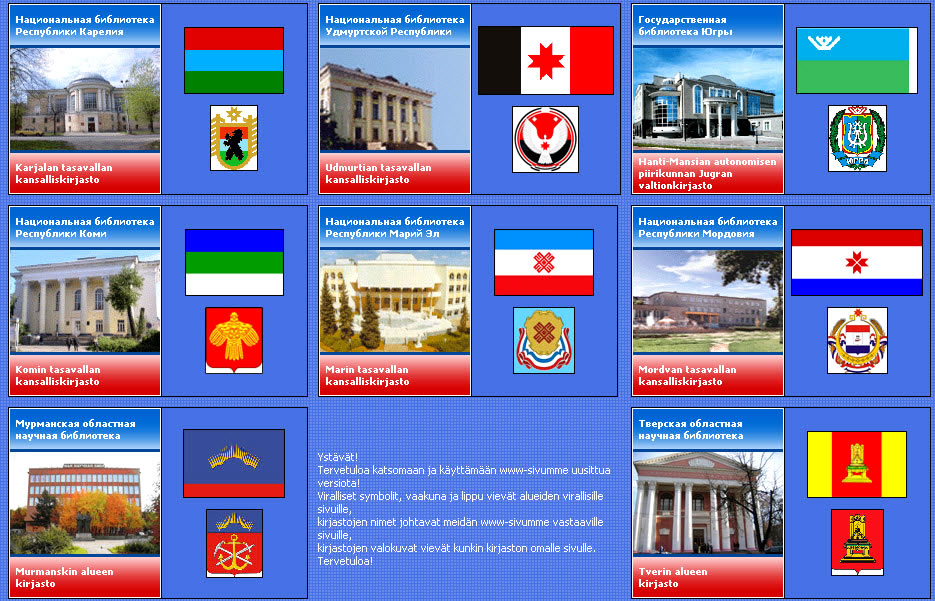
ONLINE RESOURCES
Runivers

Researchers can browse this portal for digitized materials through the left navigation bar or the main digital collection headings. Scholars can access Entsiklopedicheskii slovar’ Brokgauza i Efrona (v 86 tomakh) by selecting “Biblioteka”-“Ėntsiklopedii i Slovari”- “Ėntsiklopedicheskiĭ slovar’ Brokgauza i Efrona” -“Soderzhanie.” Researchers will able to explore pre-revolution entries for various ethnic groups. Runivers has embedded convenient features for exporting entries or sets of pages.
Note: Руниверс uses DjVu plug-in. This open source plug-in is available for standard Web browsers. Download DjVu.
UNESCO- Endangered Languages of Indigenous Peoples of Siberia
URL: http://lingsib.unesco.ru/ru/index.htm

Contributers: A.N. Bitkeeva (Aleutian, Kumandin, Nivkh, Asian Eskimo); A.A. Burykin (Mansi, Koryak, Chukchi, Even, Yukagir); A.Kh. Girfanova (Nanai, Oroch, Udeghe, Ulchi); V.Yu. Gusev (Itelmen, Kerek, Nganasan, Negidal, Enets); O.A. Kazakevich (Ket, Selkup); I.A. Muraviova (Aliutor); I.A. Nevskaya (Teleut, Shor); V.I. Rassadin (Soyot, Tofalar); A.R. Tazranova (Chelkan); D.A. Funk (Chulym Turk, Uilta)
Description: UNESCO, in partnership with the Institute of Ethnology and Anthropology, has posted electronic resources for the study of endangered languages of Siberia. Researchers can access the information through Russian-English language interface. The compilers have included the following: a bibliography section for each language and “Cultures and Languages” section for language description and analysis. Scholars can browse the website through the list of languages (left navigation menu) or by selecting the main headings.
Institut Ėtnologii i Antropologii Rossiiskaia Akademiia Nauk

Description: The institute’s offical site contains a list of electronic publications, bibliography of published materials [monographs, 2000-2010, with title page and table of contents], journal abstracts [ Ėtnograficheskoe Obozrenie , 2003-2009], and links for associations and conferences.
Federal’naia Sluzhba Gosudarstvennoĭ Statistiki Rossiĭskaia Federatsiia
URL: http://www.gks.ru/

Description: As the official online statistical portal for the Russian Federation, this website provides researchers with demographic data, regional statistics, and bulletins for health, migration trends, and education. Note: the statistical data is available in ARJ Format and html format. A search interface is attached to some documents. The website features Russian-English language interface.
Portals to the World: Finno-Ugrian (Uralic) Resources
URL: https://www.loc.gov/rr/international/int-gateway.html

Description: As part of their “Portals to the World” online guides, the subject specialists at the Library of Congress have compiled a list of electronic resources for the study of Finno-Ugric languages and cultures. List of resources includes the following: links to library catalogs, prominent research centers, and official websites for Finno-Ugric Republics in the Russian Federation.
Rossiiskii Etnograficheskii Muzei
URL: http://www.ethnomuseum.ru/
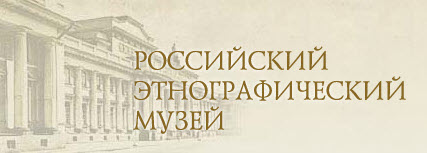
Description: The Russian Museum of Ethnography’s official website is divided into the following sections: European Russia; Siberia and the Far East; Caucasus and Crimea; Central Asia and Kazakhstan. In addition to the excellent descriptions, the museum has also published an online glossary (Tolkovyi slovar’ )[top right corner]. The glossary entries are accompanied by “affiliation chart”: ethnic group, language, religious, and territorial affiliation(see below).
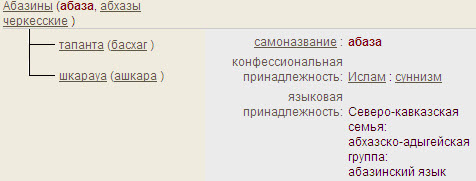
Finno-Ugorskiĭ kulturnyĭ tsentr Rossiĭskoĭ Federatsii
URL: http://www.finnougoria.ru/

Description: Finno-Ugorskiĭ kulturnyĭ tsentr Rossiĭskoĭ Federatsii (Ministerstva Kul’tury Rossiiskoi Federatsii i Gosudarstvennogo Rossiiskogo Doma Narodnogo Tvorchestva) is an online depository for publications and cultural information in Russian and Finno-Ugric Languages. Researchers can explore this website through the following sections: “Novosti”[subsections: “publikatsii”; “dokumenty”]; FUKTS RF [subsections: “informatsiia o tsentre”; “kontaktnaia informatsiia”]; “Soobshchestvo”[Subsections: “narody”; “strany i regiony”; “pechatnye Finno-Ugorskie SMI Rossii”; Letopis’ Finno-Ugorskogo dvizheniia (1990-2009). The “logos sections” contains monographs, children’s literature, literature handbooks, translations, poetry, etc. Researchers can also explore the centre’s journal publication: Zhurnal “Finnougoriia. Ėtnicheskiĭ komfort” (bottom of the page).
